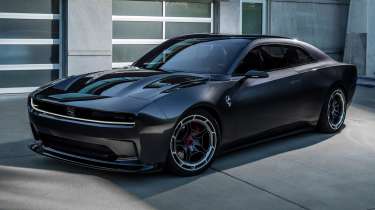Dodge Charger Daytona SRT Concept EV debuts – the first electric muscle car
American car brands have been mulling what an electric muscle car might look like – Dodge is the first to show its hand
Dodge has revealed an all-electric interpretation of the classic American muscle car with this, the Charger Daytona SRT Concept EV. The two-door four seater is just a concept for the moment, but does preview a replacement for the Challenger both in form and concept, with some fascinating new elements that Dodge is hoping will channel the soul of a muscle car into its new electric model.
This starts with the powertrain, which despite there being no horsepower or torque figures, will be more powerful than the current Hellcat, which currently sits at 807bhp in its more powerful Redeye form. Its power will be derived from two electric motors, one sat on each axle that will also make it all-wheel drive. Like the Porsche Taycan, and a growing list of other high-end EVs, the Charger will run on an 800V electrical system, but from here things get a little more unusual.
> Police-spec Dodge Charger given 1500bhp, widebody kit and AWD
The Charger Daytona SRT Concept EV features a multi-speed electromechanical gearbox called ‘eRupt’, controllable via a traditional gear selector. While most EVs don’t utilise a multi-gear transmission, Porsche’s Taycan utilises a two-speed transmission that works completely silently in the background. eRupt, however, won’t be quite so subtle.
The Charger Daytona will also feature an augmented engine noise generator, emitted from the rear of the car and then amplified through what Dodge are calling a Fratzonic Chambered Exhaust. The system will be synced-up with road speed and the transmission, with Dodge confirming that it’ll actually match the current Hellcat for volume at 126bD.
The design has been derived from the original 1969 Charger Daytona, rather than the current Challenger, but comes without the huge rear spoiler and pointed nose cone. Instead, the body’s overall design, including its sloping beltline and tall rear quarters offers a new interpretation of a classic Dodge design reborn for the modern era.
The lighting structures front and rear feature a letter-box silhouette, and at the front also acts as a wing, drawing air inside it and accelerating it over the bonnet – not dissimilar to a Ferrari 488 Pista or Jaguar I Pace. Given its relatively production-friendly proportions, we expect the road-going variant to share most of the visible design elements, although details like the wing mirrors and wheels will likely be changed.
So, if you were wondering how the American muscle car might be reimagined for the electric era, Dodge has gotten in first.





